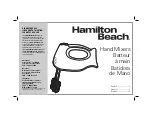
control, 4dB attenuation panned
center; 1 Mute switch; 1 dual-
mode solo switch (AFL or PFL,
globally switched); 3 output
Assign switches, delivering the
channel’s signal, relative to its
Pan setting, to the Main L-R Mix,
Submasters 1–2 and
Submasters 3–4; and 1 channel
Fader, providing up to 10dB
above unity gain. Additionally,
each channel shall include two
LED indicators; a –20/Solo LED
acting as a Signal Present
indicator by flickering and as a
channel Solo indicator by
glowing steadily; and an OL/
Mute LED, acting as an overload
indicator by flickering and as a
channel Mute indicator by
glowing steadily.
5. MIXER OUTPUT SECTION.
The mixer shall have 1 Main Mix
stereo fader, providing up to
10dB gain; 4 Submaster mono
faders, each providing up to 10dB
gain; independent left and right
Assign to Main Mix switches for
each Submaster; 1 Control
Room/Phones level rotary stereo
control, providing up to 10dB
gain; 1 Source Matrix, including 4
switches to deliver any combina-
tion of stereo signals to the
Control Room, Phones and
Meters, including Main Mix,
Submasters 1–2, Submasters
3–4 and Tape, which shall be
replaced by solo signals resulting
from the engagement of any Solo
switch; 1 rotary stereo Tape In
level control, providing up to
20dB gain; 1 Tape to Main Mix
switch; 1 Solo Mode switch to
globally determine solo type (pre-
fader listen or after-fader listen, in
place); 1 rotary stereo Solo level
control, providing up to 10dB
gain; 4 rotary stereo Aux Return
level controls, providing up to
20dB gain; two Effects to Monitor
rotary controls, providing up to
15dB gain, delivering summed
Aux Return 1 or 2 signals to Aux
Send 1 or 2, respectively; an Aux
Return 3 Assign switch, used in
conjunction with a 1–2/3–4
switch, delivering Aux Return 3
signals to one output pair,
including Main Mix, Submasters
1–2 and Submasters 3–4; an
Aux Return 4 to Control Room/
Phones Only switch; a global
Aux Return Solo switch with
associated LED; 2 rotary Aux
Send Master controls for Aux
Sends 1 and 2, providing up to
10dB above unity gain; a Solo
switch with associated LED for
each of Aux Sends 1 and 2; a
blinking master Solo indicator
LED, a Level Set LED, indicating
a PFL solo condition, a Power
indicator LED; and a Phantom
Power indicator LED.
6. METERING. The mixer shall
include 1 stereo 12-segment
LED meter with points at –30,
–20, –10, –7, –4, –2, 0, +2, +4,
+7, +10dB and Clip. The source
signals for the meters shall be
the same signals selected in the
Source Matrix, and a solo
condition shall replace the
Source selection with the
soloed channel(s). The meters
shall be calibrated so that a
0dBu signal at the Control
Room output shall be indicated
as 0dB on the meters,
±
1LED.
7. PHYSICAL CONFIGURA-
TION. The mixer shall be
made of steel and aluminum,
painted dark gray and black
with light gray graphics. The
mixer shall weigh 20 lbs, 0 oz
(9.1 kg). Included rack-mount
brackets shall allow the mixer
to be mounted in a rack
system, with either the chassis
top or the control knobs’ tops
to be flush with the rack rail.
Additionally, the jackfield
portion of the mixer, referred to
as the Pod, shall be adjustable
in three different positions;
Desktop Mode (stock configu-
ration), with jackfield connec-
tions to rear; Rack Mount
mode, with the Pod mounted
to the bottom of the main
assembly; and Roto-Pod mode,
requiring a RotoPod-VLZ (not
included), with jackfield
connections on top. Dimen-
sions of the mixer shall be, in
Desktop Mode, 4.9" (124mm)
in height, 17.4" (442mm) in
width and 17.9" (455mm) in
depth; in Rackmount Mode,
9.3" (236mm) in height, 17.4"
(442mm) in width and 12.8"
(325mm) in depth; in Roto-
Pod Mode, 6.6" (168mm) in
height, 17.4" (442mm) in width
and 17.4" (442mm) in depth.
8. SPECIFICATIONS. In
addition to specifications
already cited, the mixer shall
meet or exceed the following
specifications. Frequency
response, microphone input to
any output, 20Hz to 60kHz,
+0dB/–1dB; Total Harmonic
Distortion (THD), any input to
any output, +14dBu, less than
0.005%; Equivalent Input Noise
(EIN), microphone input to
insert send, –129.5dBm;
Common Mode Rejection
(CMR), microphone input to
insert send, maximum gain,
1kHz, –85dB; Typical Main
Output noise, all channels
assigned, odd channels panned
left, even channels panned
right, –83dBu; Signal to Noise
ratio, ref +4dBu operating level,
90dB; Attenuation, ref. 0dB @
1kHz, Main Mix level control
down, –85dBu; Channel Mute
engaged, –84dBu; Channel
Gain control down, –83dBu;
Input impedance, microphone
inputs, 1.3 k
Ω
; Channel Insert
return, 2.5 k
Ω
; All other inputs,
greater than 10 k
Ω
; Output
impedance, Tape Out, 1.1 k
Ω
;
All other outputs, 120
Ω
.
The mixer shall be a Mackie
Designs CR1604-VLZ.
Because Mackie Designs
constantly endeavors to
improve its products with
new components and
manufacturing methods, all
specifications and descrip-
tions are subject to change
without notice.
Rev 1.1
Copyright © 1996-1998 Mackie Designs Inc. All
Rights Reserved. “Mackie.”, and VLZ are
registered trademarks of Mackie Designs Inc.
MACKIE DESIGNS INC.
16220 Wood-Red Road NE • Woodinville, WA 98072 USA
Toll-Free 800/258-6883 • FAX 425/487-4337
Outside the U.S., Phone 425/487-4333 • FAX 425/485-1152
®




















